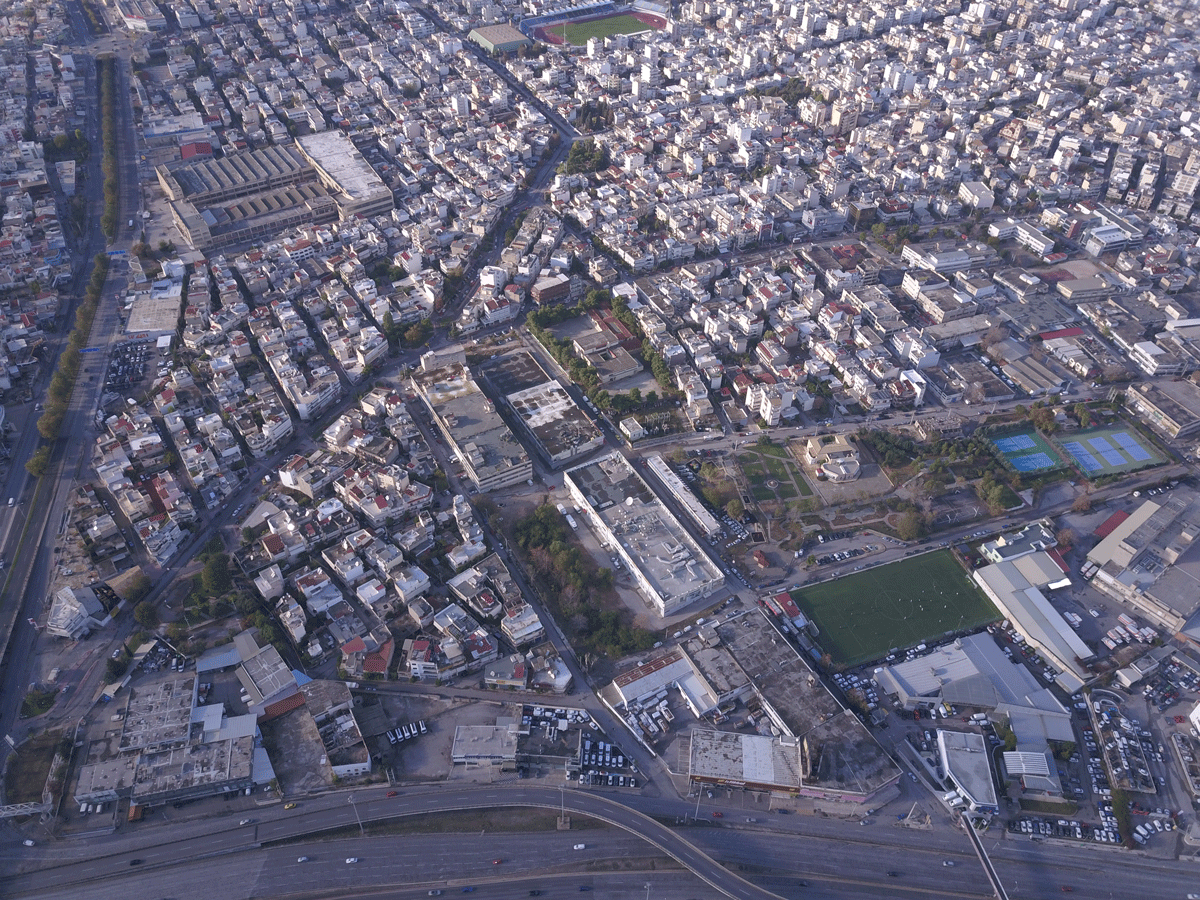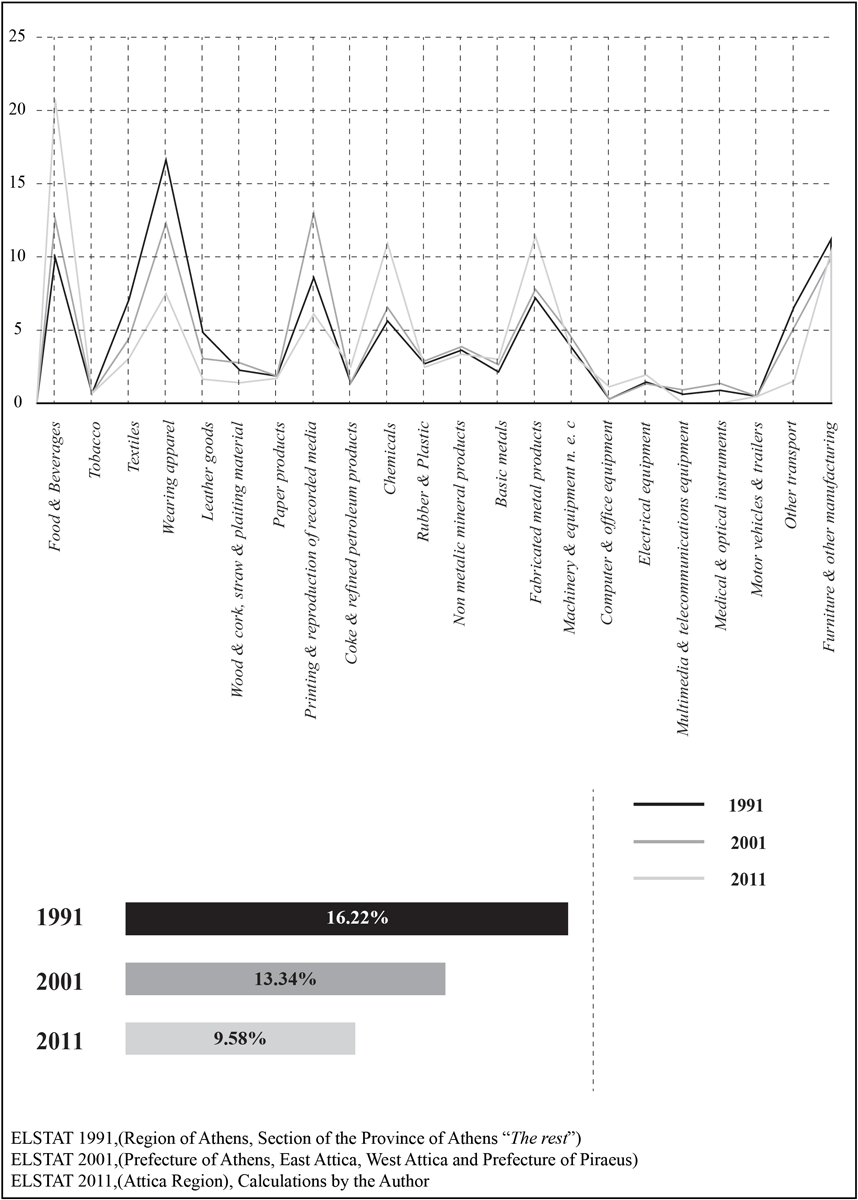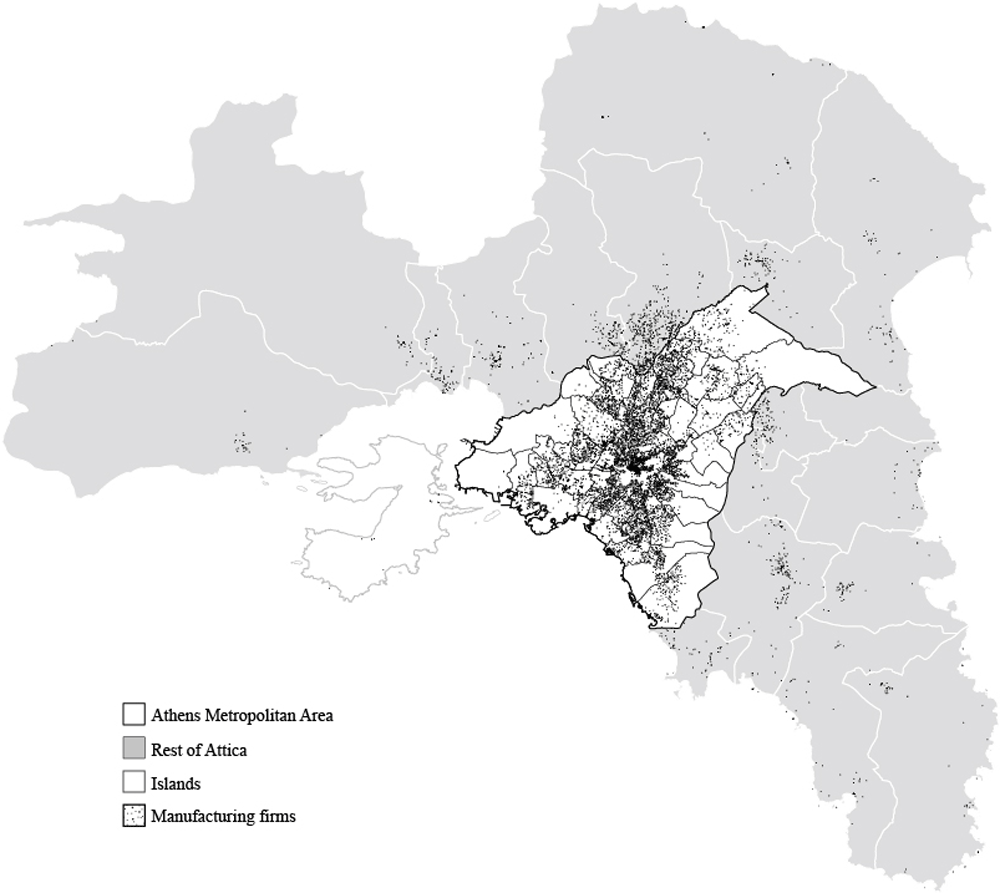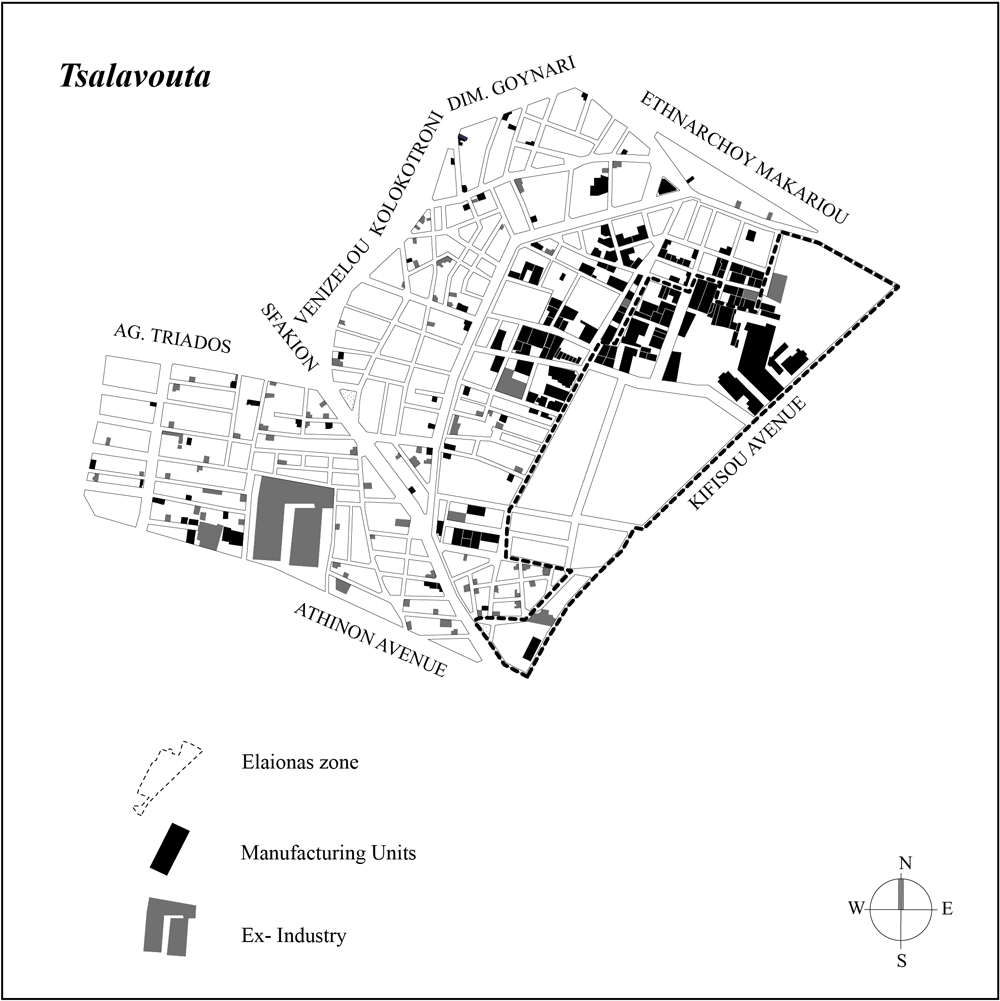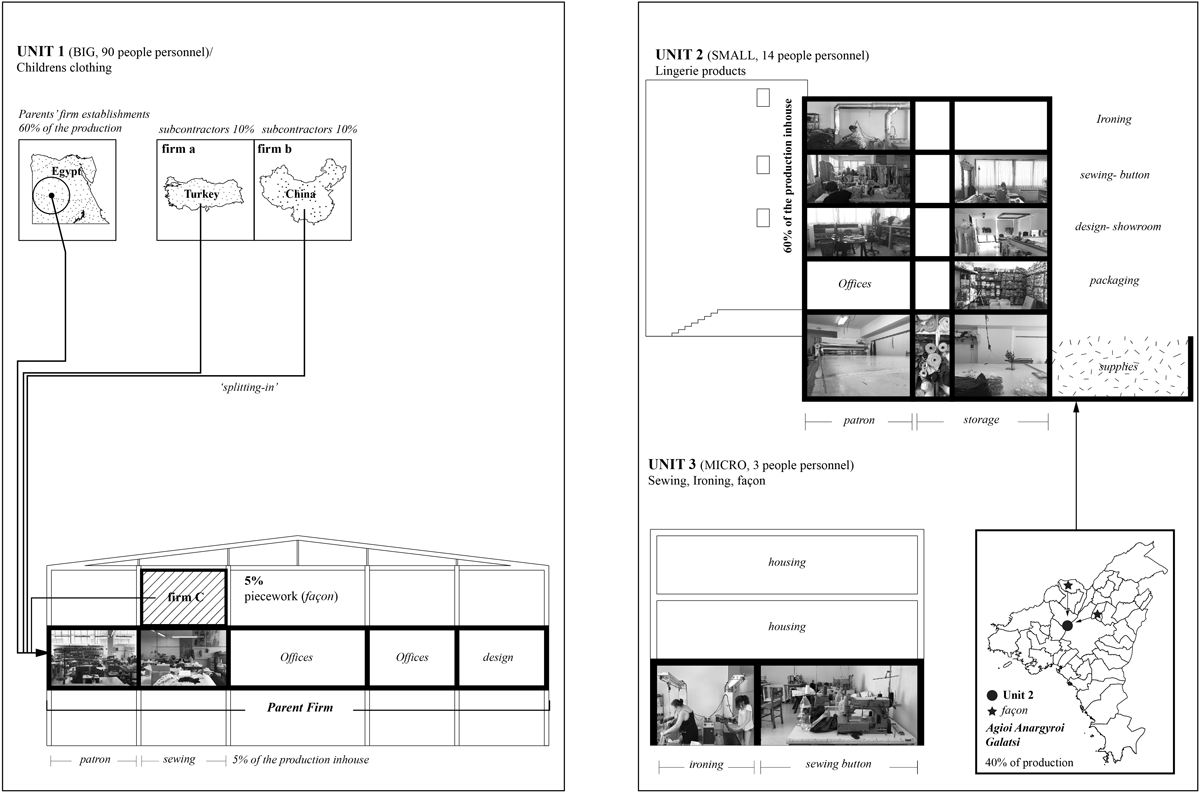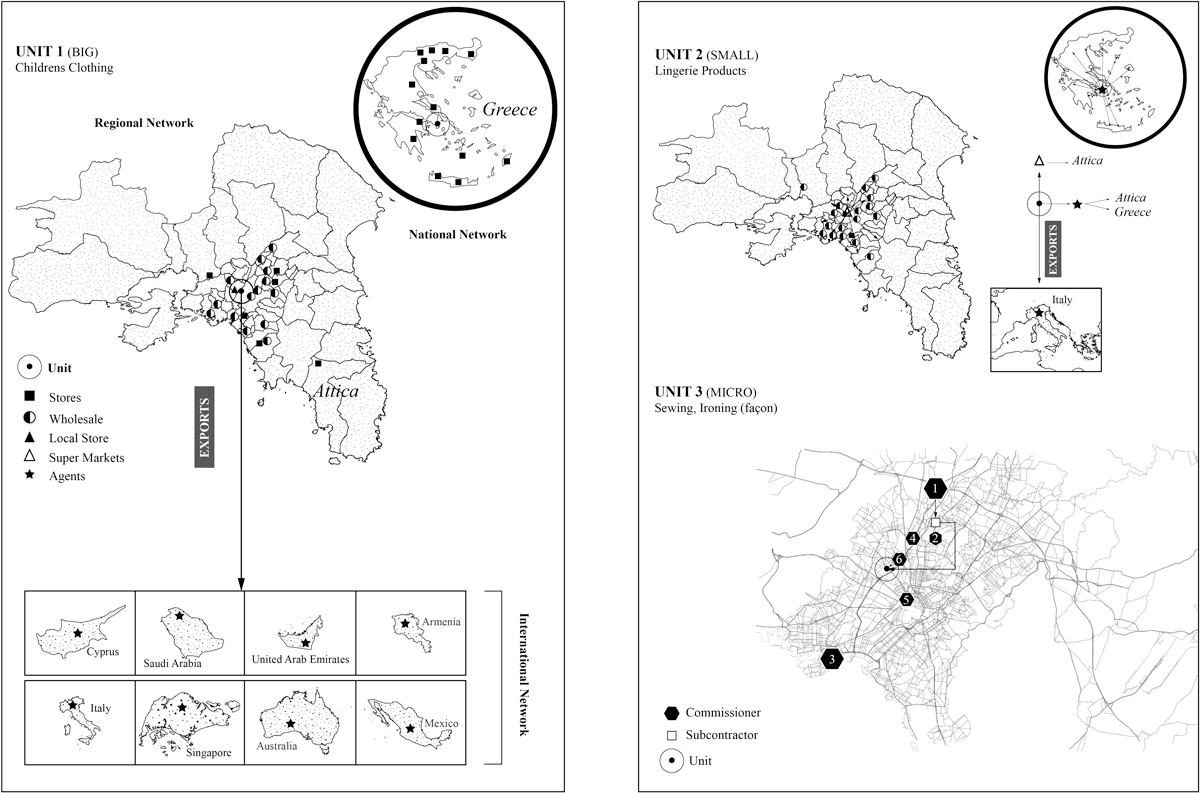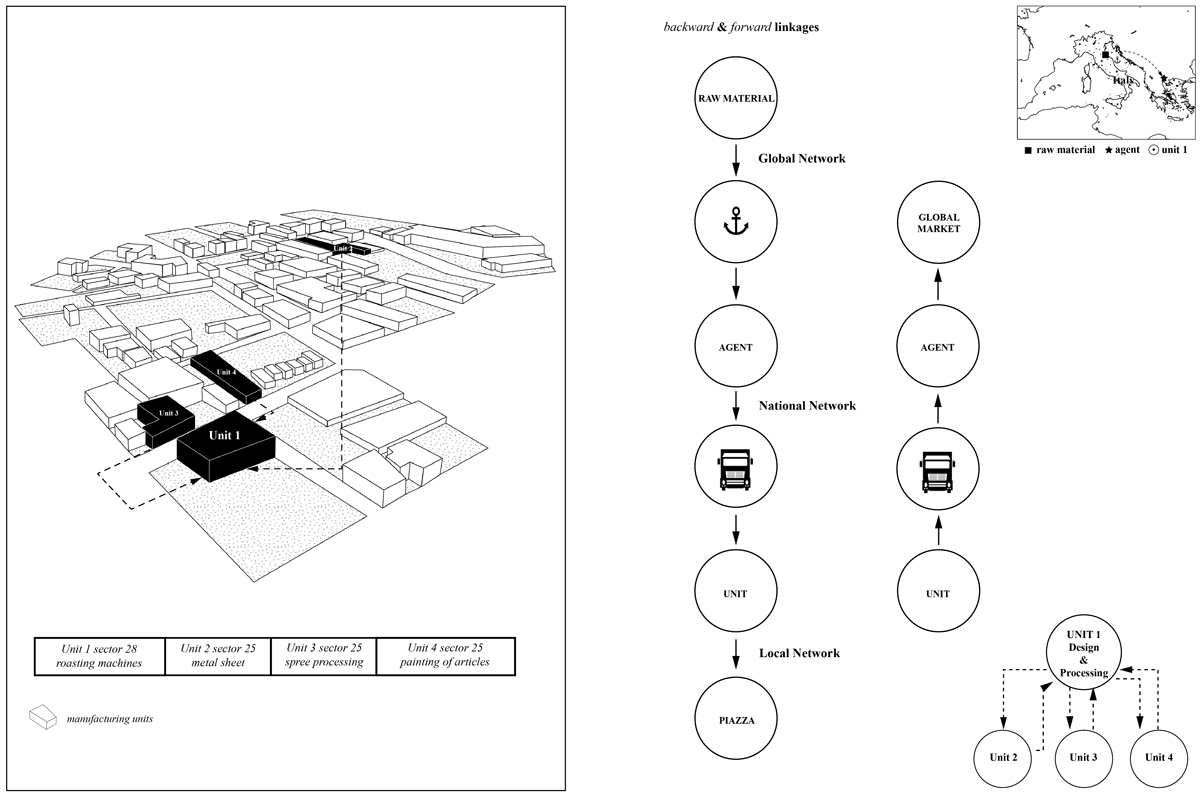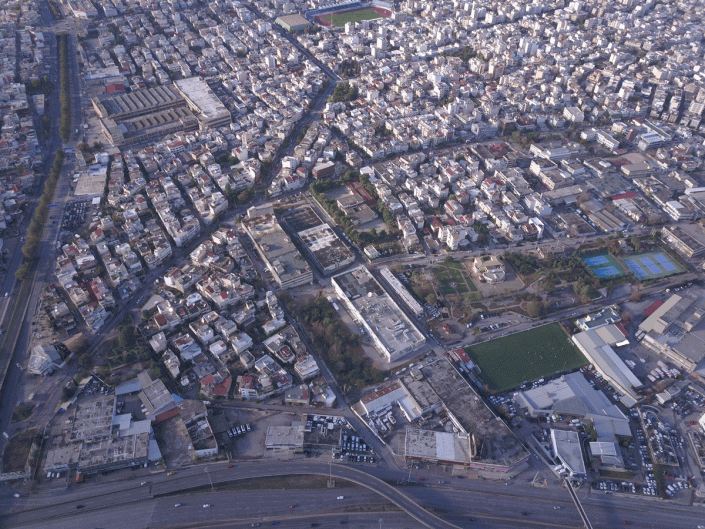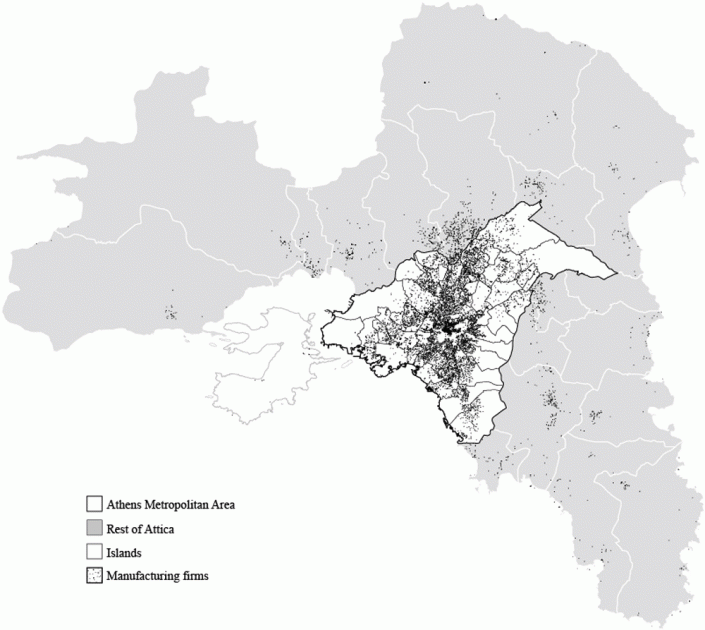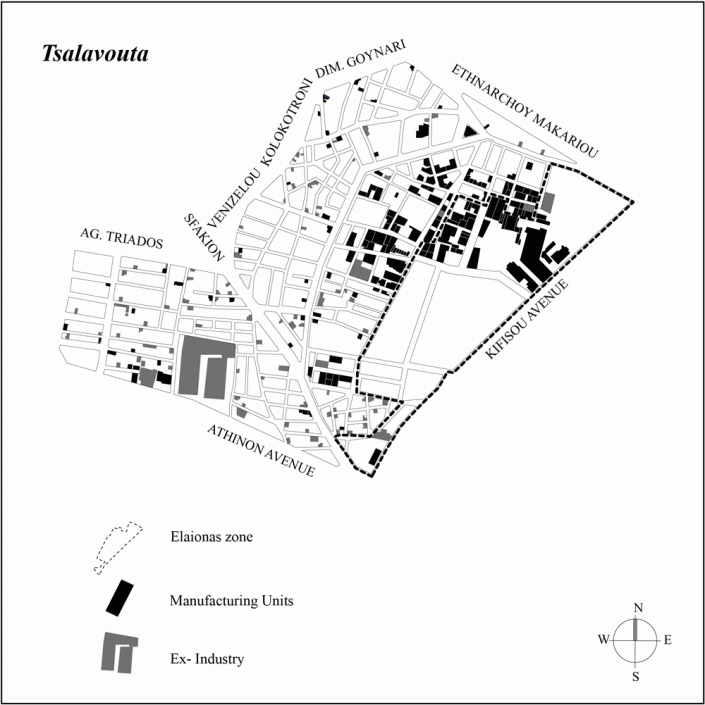The geography of manufacturing activity in Athens during the crisis
Balaoura Olga
Built Environment, Economy, Quartiers
2022 | Jun
The organisation of Greek manufacturing has relatively common characteristics with other local production systems in Southern Europe as well as with the so-called Industrial Districts (ID’s), a definition given to the Italian production systems of the Third Italy. The decentralized structure of Southern European labour markets offers a typological range (Lewis and Williams 1987; Mingione 1995) that represents common social and economic relations that have specific cultural and other characteristics (Hadjimichalis 1987; Garofoli 1992). These relationships define specific patterns of local and regional dynamics and a wide range of developmental and local characteristics, rather than a single model of development within the different ‘worlds of production’ (Storper 1997) [1].
Yet, these patterns are not signs of underdevelopment and marginalisation, but representations of a different model of industrial production and development from the dominant Western European one.
The paper examines the relationship between manufacturing activity and urban space through the investigation of the location and operation of local production systems in the local and regional economy of Athens. It focuses on the organisation of manufacturing activity at two different spatial scales. In the first part, maps and analyses the quantitative picture of the industrial location in Attica Region. Then, through empirical research, it focuses in a local production system, the industrial “piazza” Tsalavouta, located in the developmental zone of Eleonas within the boundaries of Peristeri Municipality. The area is a typical example of the Greek version of urban diffused industrialization and belongs to the traditional productive western agglomeration of the metropolitan area of Athens. The piazza consists of industrial ensembles of mostly small/ medium multi- sectoral firms and few big and very big companies [2] Similar to other paradigms of local productive systems of that kind, the area is formed by a community of people and firms engaged in local production, which consecutively progress the local division of labour by valorising the external market effect. Whereas the majority of the firms are anonymous, not following the ideal type of ‘dynamism’, their vitality and reproduction depends on the adaptation and renewal of the productive apparatus and the renewal of creative practices, achieved through local- internal to the piazza- operations of socio-economic processes. These processes are based on mutual support and cooperation, common values and the tacit rules of the piazza, the environment in which productive knowledge circulates, entrepreneurship is stimulated and mutual cooperation is promoted.
Photo 1: The industrial piazza of Tsalavouta in the developmental zone of Eleonas within the boundaries of Peristeri Municipality.
The Greek crisis brought changes that challenged the function of the system, which developed defensive and more dynamic mechanisms and adaptive modes to overcome the crisis, through the diffusion of specialisation, flexibility and cooperation. Concurrently, the integration of the system within the urban fabric, in proximity to local markets is considered important, as it gives locational advantages that facilitate the cooperation with the external to the system networks.
The geography of manufacturing in Attica regionSince 2009, crisis has strongly affected Attica region. While relevant spatial studies from the mid-1990s onwards identify all periods as “crisis periods” for manufacturing, the processed data for the current period evidently show the massive decline in the larger part of manufacturing employment and a great shrinkage in firm population. In absolute figures, 2011 was marked by the loss of almost 1⁄2 of jobs since 2001. The ratio of employment in manufacturing to the total active labour force of the region declined by 3.76% from 2001 to 2011, after it had declined by 2.88% from 1991 until 2001. Whereas the greatest decline was recorded between 2011 and 2001, significant decline had also been observed during the previous decade (the ‘growth period’) when the percentage of manufacturing in employment was particularly increased [3].
Graph 1: Timeline of the evolution of employment by manufacturing sector, 1991, 2001, 2011. Attica Region
Source: Data proceeded from ELSTAT 1991, 2001, 2011
Overall, the percentage of manufacturing in the total labour force in the Attica Region in 1991, 2001 and 2011, followed a down- ward trend reaching 16.22%, 13.34 and 9.58% respectively. The findings of the analysis strengthen the hypothesis of the research that the manufacturing decline is not a new phenomenon and although crisis has led to a massive destruction of the productive sector as the outcome of great recession and stagnation, it therefore appears as the consolidation of the previous model of financial and territorial re- organization of labour on the global, national and urban scale.
With regard to the industrial location, the research involved the processing of all the addresses of the manufacturing firms, which were geocoded for the total of 15525 enterprises of industrial activity, in all 24 industrial sectors per municipality and postal code [4].
Map 1: Distribution of Manufacturing units in Attica region, 2016
Source: Data proceeded and mapped from General Commercial Registry (G.E.MI.)
The analysis of the employment pattern and the geographical representation of the enterprises depict the actual ‘quantitative picture’ of the spatial dispersion of the manufacturing activity as well as the sectoral specialization locally and regionally.
According to the numbers of firm registries, since 1995, the region had been experiencing a deteriorating deficit in businesses population. However, in the period between 2010 and 2015 a significant decrease in the total number of enterprises (- 32.11%) is recorded in the vast majority of manufacturing sectors Almost all sectors have been marked by strong shrinkages while within a decade (2005- 2015) the number of operating firms was reduced to half. Although this massive decrease, the firm population had been following a downward trend even prior to the crisis, recording a negative percentage (-10%) between 2005 and 2008 and -27% between 2005 and 2010, prior and at the outburst of the Greek crisis.
Given the spatial concentration pattern revealed by the mapping of the firms’ current location in the Attica Region, it is observed that the metropolitan area of Athens is characterized by diffused industrialization patterns whereby groups of firms are clustered together in dense urban areas. These spillovers display multi-sectoral dispersion in the majority of the municipalities, but are basically articulated along the ‘traditional’ north and south-western agglomerations of the basin along the national road leading to northern Greece.
Attica’s sub-region has different characteristics both between its distinct territorial and administrative units (Eastern and Western Attica) and the metropolitan area of Athens. Eastern Attica has grown into a pole of dispersed manufacturing activity for both big industrial plants and small multi-sectoral activities during the past decades. These ‘recently’ industrialized areas make up agglomerations where industry, agricultural land, logistics, wholesale and big retail chains co-agglomerate.
The apparent decline in the productive sector and the restructuring that took place in the urban terrain, although it traumatised manufacturing activity regionally, did not restrain the operation of a large number of traditional and dynamic sectors. The sectoral composition of manufacturing in urban areas shows the presence of many interrelated firms and sectors in one place, at the intersection with other uses, and implies the interaction of many different agents. Given the overall pattern of manufacturing concentration, it is observed that among the main characteristics of the Attica Region is the concentration of most industries in the urban centres of the metropolitan area of Athens. Within the Athens Municipality almost 1/3 of the total population of the region’s firms is located, while Peristeri, Piraeus and other important traditional centres of manufacturing activity of the north and south-western suburbs of Athens rank among the agglomerations with the highest geographical concentration of industrial spillovers.
Local productive systems and diffused industrialisation in Athens
The study focused through empirical research [5] on a productive enclave named Tsalavouta in Peristeri Municipality, which is located on Kifisos industrial axis and is integrated within Elaionas’ developmental zone. After the massive urbanization waves in 1950, Peristeri along with the neighboring municipalities of the western suburbs grew as dynamic zones of industrial concentration combined with a dispersal of small and medium manufacturing establishments throughout the urban fabric. Whilst the social mobility of the last decades has led to the transformation of the working class neighborhood of the post-war period to a more or less petit- bourgeois neighborhood and tertiarization has massively thrived at the expense of the old, very powerful manufacturing sector, the area maintains its diversity and intense strong plurality of different uses.
Map 2: Industrial units in Tsalavouta, 2017
Source: Field research, General Commercial Registry (G.E.MI.)
In the context of this type of urban-industrial development, space is socially reproduced through a mix of multifaceted and contradictory activities, from small/medium enterprises, industries, informal activities and housing. Mixture indicates ‘tolerance’ if not ‘common way of life’ among the residents and the industrial uses, which are spread in a large part of its area’s tissue. Firms and the way they are embedded in space constitute part of the formation of the local society and vice versa. As such, the firms cannot do without the specific socio-spatial characteristics of these areas and the areas will not be the same outside the context from which they have been evolved and by which they are renewed.
The developmental dynamics is built on the economic, social and institutional particularities of the geographical space. Local productive systems such as Tsalavouta have developed within political-institutional frameworks shaped by successive regulations, institutionalized policies and adhoc practices, conjunctural choices and social compromises. The institutional framework [6] defines the conditional operation of industry in the area for the existing establishments. This usually allows the firm operation, at least formally, for as long as the life cycle of the enterprise (owner or activity) lasts, but often the licenses are transferred to new enterprises of the same sector, or of different sectors, whose activity indicated in the license does not coincide with the actual activity of the enterprise. According to the interviewees, there is a persistent trend and a relatively increased mobility in the number of firms in the area today.
However, all this complexity of the productive activity in space, in its social and historical dimension, does not seem to be considered as important by the Municipal Authority.
| Peristeri is the open-air mall of Athens; it has a large commercial market, hundreds of restaurants, ideal accessibility and three metro stations. Through the amendment of the Master Plan, new land uses have been introduced, such as culture, private health and education, hotels and leisure. The aim of the Municipal Authority is to revitalise the area by changing the land uses that are currently over-protected […] Apart from a few industrial establishments, large-scale industry has left the area. I think change is inevitable. I personally support the decentralization of manufacturing and the transformation of the area into a start-up hub with Kifissos zone to become entirely tertiarised.
Mayor of Peristeri |
The policy rhetoric for urban restructuring is usually addressed by efforts for the ‘de-contextualisation’ of an area. The words of the Mayor are indicative of an attempt to reduce the meaning and the value created by the local economy. Further, the above, reveal a vision for an urban renewal drew on spatial fixes away from both the urban context of the area and the real structure of the local and regional market.
Conclusions
One of the central outcomes is that location is still one of the basic factors for industrial establishment giving comparative advantages to urban areas embedded in a wider system (agglomeration) were important markets, suppliers and agents, numerous subcontracting enterprises and ancillary services coexist. On the one hand, the central location of Tsalavouta in the western traditional industrial agglomeration of Athens is still a cause of attraction for direct mobility access or proximity to markets where downstream markets are located (end-product industry or suppliers) and to upstream markets (raw material sources and raw material suppliers). On the other hand, the road network facilitates entrepreneurs and workers to move quickly and reduce travel costs. Even for those companies that perform corporate strategies or have adopted outsourcing, globalization has not reduced the necessity for proximity and cost reduction in selected sites within the piazza.
Distance has become much more important during the crisis as it entails travel-cost. Especially for the small and medium firms, fuel cost and investments in company vehicles provided for employees is not an affordable strategy. The entrepreneurs/ interviewees prefer to invest in working capital or technological equipment rather than commuting to a remoted establishment on the region’s fringe.
The locational context of these areas that refers to the traditional linkages of the area to spaces of employment produces two identical to these systems effects. The one concerns the relationship that results from the integration of the system into the urban fabric. Diversity (urbanization) encourages the development and also the creation of new businesses (Jacobs 1960; Rosenthal Strange 2004), interpersonal and cross-sectoral transactions and urbanization economies resulting from the presence of public goods, services and infrastructure. The city itself functions as a broader geographical system of agglomeration economies but also as an interconnection within differentiated long-distance networks – physical networks, communication networks, cultural networks and energy networks (Camagni 2001; Scott & Storper 2014).
The second effect results from the function of the piazza as a place where a whole system of interrelated practices with social and institutional characteristics is exercised (values, tacit rules of behavior, action of public and private collective bodies). The environment created by the community of people involved in the production process and the enterprises in which this is embedded – district milieu – produces opportunities for the valorisation of creativity, knowledge production and socio-cultural innovation (Camagni 1995; Belussi & Pilotti 2002; Rémy 2000) and is known for the coexistence of a climate of strong competition and, at the same time, extensive cooperation (Becattini & Musotti 2003).
The transactions among the companies produce a high level of diffused specialization, local know-how and creative techniques. The division of labour is inherent within the workshop, the phases and functions among the enterprises’, shaping the ‘community market’ (Dei Ottati 1994; 2017) and is further extended in the global market niches. Flexibility does not always imply technology. The ‘piazza’ functions as a workshop where different specializations can ‘satisfy’ the final demand as a whole. The client (final demand) can switch firms (of the same or interrelated sectors) in different phases of production to get the final product. The division of labour thrives within all spatial scales and networks articulated between the different links (producers, suppliers, clients, commercial agents, subcontractors) bringing back increasing returns. Even big and very big companies with vertical integration systems benefit from external to their production activities provided by the district-based firms (packaging, printing services, etc.).
Graph 2: Production Networks. Three wearing apparel industries
Source: : Empirical research, Ο Balaoura
Graph 3: Local and global distribution networks. Three wearing apparel industries
Source: : Empirical research, Ο Balaoura
The ‘piazza’ turns into reference loci where a whole system of interrelated practices is exercised. Interaction among enterprises means trust and common sense in reference to the area and therefore all firms follow the ‘piazza’s rules’. In essence, an internal governance is implemented with reference to a firm based community. The ‘piazza’ is both a pool of specialized workforce that firms trust and prefer in hiring personnel and the environment where labour is a negotiable issue depending on the employees’ skills and his/ her personal commitment to the efficiency of the firm operation, which almost always presupposes flexible/ informal practices. Efficiency then, becomes both an in-house and collective to the area project. An inherent part of piazza’s rule is still “informality”, a series of informal practices, which are nowadays extremely exacerbated as flexibility and precariousness have to a large extent acquired an institutional character. Informality is evident both in labour relations, with greater intensity in the gendered and racial dimension – to the detriment of women and migrants-, in the inadequacy of health and safety conditions in the workplace and the deficient private and public infrastructure of the urban environment of the piazza.
Graph 4: Local synergies. Metal and machinery construction
Source: : Empirical research, Ο Balaoura
Another crucial outcome, which is essential in the configuration of the local productive systems, is the ‘district effect’ (Signorini 1994; Becattini & Dei Ottati 2006) created by the strong presence and co-operation of a population of SMEs with a variety of same sub- sectoral characteristics and trans-sectoral variants involving different phases of production. The interrelated economies generated within the district result in ‘external economies of scale’ (Asheim 1994; Amin & Cohendet 2000), economies that are external to the firm and internal to the area, providing competitive advantages and increasing returns to the community [7]. The transactions among the companies produce a high level of diffused specialization, local know-how and creative techniques. However, local creativity and flexibility are not an inexhaustible resource for the survival and sustainability of these systems, especially in conditions of extensive crises and global competition. Although the firms in Tsalavouta have made a series of new adjustments to the changing conditions of the business environment including technological modernization, in contrast to the past, are still subject to significant constraints considering the constant changes in the geography of production and technological progress. In Greece, no technological and scientific institutional structures that would offer guarantees for increasing the developmental dynamism of production were included, compared to other local production systems in Mediterranean (see Vazquez Barquero 1987; Courlet & Pecqueur 1992; Garofolli 2002), where public policy interacts with private actors, universities, research centres, financial and other mechanisms, to develop projects that stimulate the local economy.
Globalization and especially the Greek crisis came to amplify these deficiencies and put further barriers to firms attempting to enter global competition. Despite these developments and considering that investment in technology takes place during periods of economic growth, a wide range of firms in the area managed – especially during the crisis – to grow and spatially reach global markets through exports.
Many small enterprises in the sample are small and micro enterprises with a dominant family structure. This feature makes them more the results of a project of life than that of a financial enterprise. This fact allows them a superior resilience during short crises, because such entrepreneurs put extra-resistance to financial difficulties, mobilizing their own resources and those of the relatives and friends, to overcome the recession. During the Greek crisis, many businesses survived on private resources, due to limited access to bank loans, credit and financial resources and state-led development aid.
Finally, another crucial observation made through the empirical research is that a great number of the entrepreneurs’ offspring is engaged into the production process. Research in past surveys (see Mingione 1995; Maloutas 2007), observed an extended indifference of the younger members to continue the family business, due to the social mobility of the last decades that led to the upgrading of educational levels and the choice of occupations in the tertiary sector by a large part of the population. Contrary to the findings of the above studies, during the crisis, and due to its impact on unemployment and widespread insecurity, there is a strong tendency for members of the younger generation to return to the family businesses. A new, highly skilled generation has thus entered the businesses, gaining strategic positions and successfully renewing them, in design product, technological and organisational know-how.
[1] This typological range of production patterns in Southern Europe, although having common characteristics, has not followed and is not following common developmental paths. In regions where Fordism has never been hegemonic, development has been driven by flexible industrial production ensembles of small and medium-sized enterprises. After the 1970s, some of these regions in Europe and USA became symbols of the success of ‘flexible small-scale capitalism’, while others consisting of what the literature refers to as ‘ordinary’ SMEs were ignored both in terms of the economic theory and regional development policy (for a detailed description see. Amin & Robins 1990; Hadjimichalis 2011)
[2] During the field research, a total of 150 addresses were identified. According to the sectoral hierarchy, the sector of metal products concentrates the majority of the units (key-sector). Textiles, wearing apparel, and leather shoes as a sectoral system (former key-sector) and furniture production are strongly represented while food production and manufacturing of machinery and equipment follow. Of remarkable importance are the sectors of plastic products and printing materials.
[3] The analysis on a regional scale included the processing of data from the demographic and employment census of ELSTAT for the last three population censuses (1991, 2001, 2011).
[4] The analysis and mapping of the geographical dispersion of all manufacturing units in the Attica Region was based on a data set provided by the General Electronic Commercial Registry (G.E.M.I.) and refers to the sectoral specialization defined in NACE Rev.2 for the 24 different sectors of manufacturing, the addresses and postal codes of enterprises for the years 2015-2016.
[5] The method included empirical research through field mapping and interviews with entrepreneurs and employees of the industrial units as well as key informants of the area (representatives of the municipal authority, residents, members of professional chambers, etc.).
[6] Presidential Decree of Eleonas (Government Gazette 1049/D/1995), Master Plan of Peristeri Municipality l.1337/1983, l.2508/1997.
[7] On conceptual aspects of the ‘district effect’, see Becattini & Musotti 2003; Becattini 2004; Dei Ottati 1994; Signorini 2000; Becattini & Dei Ottati 2006; Becattini et al. 2009
Acknowledgements
The text is based on research conducted by the author in the context of her doctoral dissertation (Balaoura, 2018) at the Università Iuav di Venezia, supervised by Paola Viganò and Dina Vaiou. I warmly thank them both
Entry citation
Balaoura, O. (2022) The geography of manufacturing activity in Athens during the crisis, in Maloutas T., Spyrellis S. (eds) Athens Social Atlas. Digital compendium of texts and visual material. URL: https://www.athenssocialatlas.gr/en/article/manufacturing-in-athens-during-the-crisis/ , DOI: 10.17902/20971.107
Atlas citation
Maloutas T., Spyrellis S. (eds) (2015) Athens Social Atlas. Digital compendium of texts and visual material. URL: https://www.athenssocialatlas.gr/en/ , DOI: 10.17902/20971.9
References
- Amin A and Robins K (1990) The re- emergence of regional economies? The mythi- cal geography of flexible accumulation, Society and Space, 8, 7–34.
- Amin A and Cohendet P (2004) Architectures of knowledge : firms, capabilities and communities. Oxford: Oxford University Press.
- Asheim B T (1994) Industrial districts, inter-firm co-operation and endogenous technological development: the experience of developed countries in Technological Dynamism in Industrial Districts: An Alternative Approach to Industrialization in Developing Countries? New York and Geneva: UNCTAD, 91–142.
- Becattini G (2004) Industrial Districts. A New Approach to Industrial Change, Cheltenham, Edward Elgar.
- Becattini G and Ottati D G (2006) The performance of Italian districts and large enterprise areas in the 1990s. European Planning Studies 14 (8), 1139-1162.
- Becattini, G. & Musotti, F. (2003) Measuring the district effect. Reflections on the literature, Banca Nazionale del Lavoro Quarterly Review, 226, pp. 259–290.
- Becattini G, Bellandi M and De Propris L (eds) (2009) A handbook of Industrial Districts. Cheltenham: Edward Elgar Publishing.
- Belussi, F., and Pilotti, L. (2002) Knowledge creation, learning and innovation in Italian industrial districts, Geografiska Annaler, 84: 19-33
- Courlet C and Pecqueur B (1992) Les sistèmes industriels localisés en France: un nouveau modèle de développement’, in G. Benko and A. Lipietz (eds) Les régions qui gagnent. Districts et réseaux: les nouveaux paradigmes de la géographie économique. Paris: Presses Universitaires de France.
- Camagni, R. (1995) The concept of innovative milieu and its relevance for public policies in European lagging regions, Papers in Regional Science, 74: 317-340.
- Camagni R (2001) The economic role and spatial contradictions of global city-regions: the functional, cognitive and evolutionary context in Scott, A. J., 96-118.
- Chronaki Z, Hadjiimichalis C, Labrianidis L and Vaiou D (1993) Diffused Industrialization in Thessaloniki: From Expansion to Crisis. Oxford: Blackwell Publishing.
- Dei Ottati, G. (1994): Cooperation and competition in the industrial district as an organization model. European Planning Studies, 2 (4): 463-83
- Dei Ottati G (2018) Marshallian Industrial Districts in Italy: the end of a model or adaptation to the global economy?, Cambridge Journal of Economics, 42 (2): 259–284
- Garofoli G (1992) Endogenous Development in Southern Europe, Aldershot:Avebury.
- Garofoli G (2002) Local Development in Europe: Theoretical Models and International Comparisons. European Urban and Regional Studies, 9 (3): 225-239.
- Hadjimichalis C (1987) Uneven Development and Regionalism: State, Territory and Class in International Journal of Urban and Regional Research, London: Croom Helm.
- Hadjimichalis C (2011) SMEs, entrepreneurialism and local/regional development. In: Pike Α, Rodríguez- Pose A and Tomaney J. Eds., The Handbook of Local and Regional Development, Oxford: Routledge, 381- 293.
- Hadjimichalis C and Vaiou D (1990) Flexible labour Markets and regional development in northern Greece. International Journal of Urban and Regional Research, 14 (1): 1-24.
- Jacobs J. 1961. The Death and Life of Great American Cities, New York: Random House.
- Lewis J R and Williams A M (1987) Productive Decentralization or Indigenous Growth? Small Manufacturing Enterprises and Regional Development in Central Portugal, Regional Studies, 21:4, 343-361
- Maloutas T (2007) Middle class education strategies and residential segregation in Athens, Journal of Education Policy, 22:1, 49-68, DOI: 10.1080/02680930601065742
- Massey D (1984) Spatial Divisions of Labour: Social Structures and the Geography of Production, London: Macmillan.
- Mingione E (1995) Labour market segmentation and informal work in southern Europe. European Urban and Regional Studies 2 (2): 121-143.
- Rémy, J. (1999): La ville, phénomène économique, Paris, Economica.(2000): «Villes et milieu innovateurs: une matrice d’interrogations», in Crevoisier, O., and Camagni, R., 33-43.
- Rosenthal S and Strange W (2004) Evidence on the nature and sources of agglomeration economies, in Henderson, V., and Thisse, J. F. (eds.), Handbook of regional and urban economics, 2120-2143.
- Sayas J (2001) Social and Spatial Division of Labour in Urban Space. The Case of Industrial Activity in the Prefecture of Attiki, 1978-1988. PhD Thesis, Department of Urban and Regional Planning, Faculty of Architecture, National Technical University of Athens
- Scott A and Storper M (2014) The nature of cities: the scope and limits of urban theory, International Journal of Urban and Regional Research 39 (2015): 1-15.
- Signorini L F (1994) The price of Prato, or measuring the industrial district effect, Papers in Regional Science, vol.73, 369-72.
- Signorini L F (2000) L’effetto distretto: motivazioni e risultati di un progetto di ricerca, in L.F. Signorini (ed.), Lo sviluppo locale. Un’indagine della Banca d’Italia sui distretti industriali, Rome: Donzelli.
- Storper M (1997) Regional Economies as Relational Assets. In: Lee, R. and Wills, J., Eds., Geographies of Economics, Arnold, London, 248-258
- Vazquez Barquero A (1987) Local Development and the Regional State in Spain, Papers of the Regional Science Association, 61: 65–78.
- Βαΐου N, Γολέμης Χ, Λαμπριανίδης Λ, Χατζημιχάλης Κ και Χρονάκη Ζ Άτυπες μορφές βιομηχανικής παραγωγικής-εργασίας και αστικός χώρος στο ΠΣΠ Ερευνητική εργασία (ΓΓΕΤ), 1993-96.

